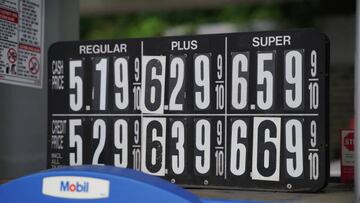Gas prices: In which states is it more expensive and in which ones is it cheaper?
States are seeing some of the highest gas prices in US history. Where are prices most and leave expensive?


The average price of a gallon of gas in the US has hit $4.95 for Regular, $5.30 for Mid-Grade, $5.59 Premium, and $5.71 for Diesel. Up almost $2.00 across the board compared to prices paid at the pump last year.
Which states have seen the largest jump in price over the last week?
- Michigan (+45 cents)
- Illinois (+41 cents)
- Indiana (+41 cents)
- Wisconsin (+39 cents)
- Ohio (+38 cents)
- Nebraska (+37 cents)
- Kentucky (+36 cents)
- Colorado (+35 cents)
- Minnesota (+34 cents)
- Texas (+32 cents).
The state paying the highest for a gallon of regular gasoline is California where the gallon has reached $6.39. Governor Gavin Newsom has proposed a gas stimulus check or rebate for up two cars per household to offset costs for residents. Drivers will be able to receive $400 per vehicle.
Other states where prices remain high include Nevada ($5.56), Illinois ($5.53), and Hawaii ($5.49).
States and territories with the most expansive gas markets
- California ($6.34)
- Nevada ($5.49)
- Hawaii ($5.47)
- Oregon ($5.41)
- Washington ($5.40)
- Illinois ($5.40)
- Alaska ($5.37)
- Washington, D.C. ($5.06)
- Ohio ($5.06)
- Michigan ($5.05).
On the other side of the spectrum, the news is not much more positive. Georgians are paying on average $4.37 for a gallon of regular, followed by Arkansas where the average price is $0.10 higher.
Which states have the highest gas taxes?
At the federal level, there is a $0.18 tax applied to all gallons of gas purchased across the country. The average state gas tax across the US is $0.27. States with the highest rates are Pennsylvania ($0.57), California ($0.51), and Washington ($0.49). Those with the lowest gas taxes included Florida ($0.04), Alaska, and New York ($0.08).
Are prices expected to decrease?
Related stories
Not any time soon. The White House has said that there is little they can do at this point to bring down prices and with summer arriving, demand is surging as people travel and take advantage of the warm weather.
Last week the Energy Information Administration reported gasoline stocks continued to fall. The figures have been on the decline since the Russia invasion of Ukraine, highlighting, once again the pressure the war has placed on global energy markets. The federal agency has also adjusted their Short-Term Energy Outlook to predict that all non-OPEC countries will increase petroleum production by an average of 1.9 million barrels of oil a day. The trends are expected to continue with an addition 1.4 million barrels being added on top of the nearly two million to be seen this year. The news of such a rapid increase in production is extremely for those concerned about climate change. At a time where climate scientists are saying we have a short window to take action, geopolitics have brought the crippling dependence on fossil fuels to light.

